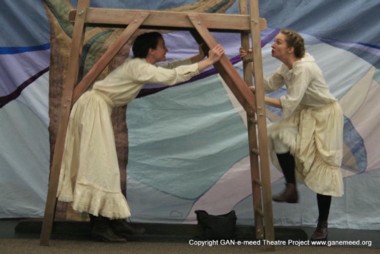One-person shows are a familiar landmark in the theatrical landscape. Last year I saw over a dozen of them. But there were also a dozen two-character plays on my itinerary. That’s another popular low-tech form, one that has quite a different feel and focus than the solo show and which often captures the essence of theater.
In my experience, two-character plays come in two varieties. Some follow the arc of a relationship over time, while others zero in on a single real-time encounter to illuminate and alter a relationship. Both types tend to be compressed expressions of larger dramas, focusing all the dramatic energy on a single dyad. Some are fully fleshed-out narratives; others serve more as character studies. And while one-person shows often involve multiple characters—tour-de-force opportunities for a solo actor—most two-actor plays are concentrated on a single face-to-face dance.
The best-known example of the extended two-character narrative may be Love Letters, A.R. Gurney’s epistolary history of a lifelong friendship. It was performed last January at the Academy of Music by Vincent Dowling and Mary Linda Rapelye. Another lifetime connection is traced in Julie Jensen’s Two-Headed, staged in the Valley last May by GAN-e-meed Theatre Project with SerahRose Roth and Kara Manson. There, two women in 19th-century Utah clash over their opposing attitudes toward Mormonism but cling together for feminine support in a rigid patriarchal society.
Of the two-handers I saw in 2012, only that one featured a pair of women. Three were men-only affairs and the rest co-ed. The guy-guy encounters included John Logan’s Red, which I saw in two versions, at New Century Theatre and TheaterWorks; Rajiv Joseph’s The North Pool at Barrington Stage Company; and “They Fell,” one of the short pieces from John Cariani’s Almost, Maine in Greenfield’s Double Take Festival.
Each of these, involving varied modes of character interaction and revelation, illustrated a distinct approach to the genre. Red, by John Logan, centers on Mark Rothko, with his young assistant serving primarily as a sounding board for the painter’s pontifications and a foil for his ego—in effect, a one-person play with interlocutor. The North Pool is a brief, charged encounter between a young student and his school’s vice principal, in which secrets and home truths are gradually uncovered. And in “They Fell,” two beer-drinking buddies’ complaints about bad dates with impossible women lead to the discovery that they’re in love with each other.
The two-person form is frequently rooted in an unequal relationship of contrasting personalities, which then turns on the pivot of their encounter to shift the balance of power. Two plays at Hartford’s TheaterWorks last year exemplified that dynamic. Karoline Leach’s Tryst, a melodrama set in Edwardian London, paired a lonely spinster with an unscrupulous fortune hunter, culminating in not one but two turns of the screw. And Venus in Fur, by David Ives, pitted an overbearing director against an eager young actress in a cat-and-mouse game that embodied the play’s sadomasochistic theme.
All theater, whether intimate drama or expansive epic, is about relationships. In the two-character play, that most fundamental aspect of human nature receives its ultimate distillation.•
Contact Chris Rohmann at StageStruck@crocker.com.



